Gaijinpot Blog


Kids’ Summer Homework in Japan: With Friends Like These
For better or worse, summer-long school assignments have been a family affair in Japan for longer than you might think.
By Aonghas Crowe Aug 27, 2021 6 min read
As I’m knocking back some imo jochu (sweet potato shochu) during the Obon holiday, my wife tells me she needs me to go take some photos in front of our local train station.
“What for?”
Our son’s jiyu kenkyu (independent research project), she tells me.
Jiyu kenkyu, for the uninitiated, is one of the major headaches confronting Japanese kids and their parents during the natsu yasumi (summer break), sometimes also referred to as 夏 ( ) 季 ( ) 休 ( ) 暇 ( kaki kyuka ) on some school calendars sent home to parents. In an open-ended research project, students are allowed to choose what they will study but must produce a poster of their findings that is then presented at school. The best projects are sent to a regional contest, with the winning entries bumped up to a national contest.
Summer break friend
As a bio-chem major, the notion of jiyu kenkyu strikes me as rather good—it compels children to examine the world around them, to be curious about its phenomena and to conduct an investigation, inculcating them with the Scientific Method at the tender age of 8. In the past years, my elder son has built handmade vacuum cleaners out of plastic bottles using different sized motors and blades and power sources.
It was not only fun (and a little dangerous), but also quite educational. It helped him along a path of building and tinkering, something that he still loves to do today.
The problem with jiyu kenkyu is that it is only one small but time-consuming part of the thick bundle of summer homework euphemistically called “ natsu yasumi no tomo ” (“summer break friend”)—and boy, with friends like that…
It includes an 80-page workbook with drills covering each subject, extra printouts for kanji (Japanese characters) and math study, reports, diaries, art projects, calligraphy, book reports and producing the front page of a newspaper. In addition, there are a slew of contests for essay writing, artwork, calligraphy, haiku (poetry) and more.
What do parents think?

Switch on any terebi anime (animated TV show) in the final week of the summer break and you will surely find cartoon parents yelling at their children to finally hit the books, a standard theme of popular shows like Sazae-san and Doraemon .
In a survey conducted by PR Times , two-fifths of parents said that although their children managed to get through the bulk of the work at the start of the summer break, the book reports and jiyu kenkyu tended to be put off until the very end of it. That’s been the case in our home, too, requiring me to put my shochu down and hump over to the station and snap some photos.
Half of the parents in the survey reported also having to help their children with their research projects. Another 40% helped with the book report, which in my younger son’s case ended up being six handwritten pages long; while another 34% assisted with the art project. Only 16% said they didn’t lend their children a hand at all.
Growing up in America, homework was the very antithesis of summer vacation, which in my day lasted three glorious months and was spent entirely at our cabin in the San Bernardino mountains east of Los Angeles, swimming, playing shuffleboard and ping pong, hiking and—most importantly—forgetting half the stuff our teachers had tried to cram into our thick skulls during the previous nine months. Come to think of it, I doubt I even read books back then, whereas my sons today devour several books a day, sometimes in one gulp.
Cramming and more cramming
But, naturally, they have different ideas here in Japan about the purpose of kaki kyugyo , as the summer break is officially called. One of the main purposes of it is to instill in children the ability to learn independently. All well and good, but sheesh—talk about wet blankets!
Most elementary school kids, though, have it comparatively easy. At least they can spend time with their “summer break friend” in the comfort of their own home. The older children get, however, the more likely they will be doing hard time at a juku (cram school).
Two-fifths of sixth graders, according to Child Research Net , attend extracurricular cram schools. That figure rises to almost 60% in the third year of junior high school. Many juku hold special summer break “camps,” which might sound like teepees and totem poles, but actually involves studying sometimes 12 or more hours a day, with daily tests determining the seating arrangement of the students—the sharp-witted twirling mechanical pencils in the front of the class; the dolts slumped in a miasma of self-loathing in the very back row. In high school, the drudgery of cram schools is replaced by kagai jugyo , supplementary lessons held throughout most of the summer “break.”
Switch on any terebi anime (animated TV show) in the final week of the summer break and you will surely find cartoon parents yelling at their children to finally hit the books…
Is all this cramming, all these projects, all this review really necessary? Well, according to a survey by the advertising company Eole , 65.4% of parents believe it is, a figure that was mirrored in the PRTimes survey. However, 37% felt that calligraphy wasn’t (probably because cleaning up the mess afterward is a major hassle), 36.3% said that the poster was a waste of time, while 30.1% felt the book report could be done away with (again probably because two-fifths of parents had to help them with it).
The only true authority: my wife
Naturally, the only Japanese parent’s opinion I really give a tinker’s damn about is my wife’s. When I asked her the same question, she said that she was far more shocked to learn that American kids had none. After some thought, she said, “Come to think of it, the only reason parents today don’t question the need for summer homework is that they had to do it themselves when they were young.” And she’s right: Natsu yasumi no tomo has been around since the Taisho era, meaning her great-grandparents also had to do it.
“Oh, and don’t forget to take those photos,” she adds. “Chop-chop.”
With a sigh, I put my sweating glass of shochu down, push myself out of the chair, grab my ichigan refu (single lens reflex) camera, then head out the door.
This year’s jiyu kenkyu is about CO2 levels found in the environment. Apparently, my son picked up a kit containing phenolphthalein, a chemical compound that is used as an indicator in acid-base titration. A weak acid, the deprotonated ion is fuchsia in color. When in contact with CO2, however, the color fades. The faster the color fades, the higher the level of C02.
My son predicted that due to all the car and bus traffic around the station C02 levels would be high, but to his surprise, they were not.
At first, he guessed it may be due to the fact that almost 40% of new cars sold in Japan now are so-called “next generation,” namely, electric, hybrid and so on. What we learned was that it was actually hard to record atmospheric CO2 levels with cheap kits from hobby shops. (The quickest reactions, incidentally, were triggered by gas from carbonated drinks and air fresheners.)
And so, like generations of Japanese parents before me, I can only acquiesce, despite the constant niggling. I find some solace in the fact that my son didn’t bother asking daddy to contribute some of his hot air for the project.
How is summer homework for your school-age children handled in your home? Do you get as involved in the projects as the kids? Or do you scramble to help as the return to school approaches? Let us know win the comments!

Aonghas Crowe
Hakata-based American writer, translator and student of Japanese dialects and literature.
More articles by Aonghas Crowe
Leave a Reply Cancel reply
Your email address will not be published. Required fields are marked *
Post comment
This site is protected by reCAPTCHA - Privacy Policy - Terms of Service
How to Read Your Gas Bill in Japan
Here's what you need to know about your gas bill in Japan.
By GaijinPot Blog Sep 2, 2024 5 min read

10 Popular Dating Apps in Japan
Looking for love? Interested in meeting new people? Check out these 10 dating apps that are popular in Japan.
By Whitney Hubbell Aug 30, 2024 8 min read

Asakusa Treasures: Musashi Japan Knives
Looking for the perfect souvenir to commemorate your trip to Japan? Head to Musashi Japan for the traditional handcrafted knives.
By Heidi Sarol Aug 29, 2024 3 min read

- Employers Area
- List Properties
- Advertise on GaijinPot
- © 2024 GPlusMedia Inc.
- Terms of Use
- Privacy Policy
Japan, Anime, and Manga Essay Ideas for Homework Assignments

So, it is time I did my part! This article will give you ideas for future writing assignments and show you how to read (and use) references and citations. I will provide writing ideas and links to articles relating to the topic. You are welcome to cite me; however, I have already done some of the research legwork in my short bibliographies. I hope the articles will provide a good spring board for your essay assignments.
Understanding and Using Citations

Author, A. A., Author, B. B., & Author, C. C. (Year). Title of article. Title of Periodical, volume number (issue number), pages. http://dx.doi.org/xx.xxx/yyyyy –from Purdue Owl
By the way, that url looking thing is called a Digital Object Identifier. It works like a blog post’s permalink. You can paste the DOI at this website to link to the article. For example this citation:
Suzuki, Michiko (2006). Writing Same-Sex Love: Sexology and Literary Representation in Yoshiya Nobuko’s Early Fiction. The Journal of Asian Studies. 65. p.575. doi:10.1017/S0021911806001148.
You can paste that gobblygook (excluding the period) after doi: into the website to find the article. Give it a try! Why not use a regular hyperlink? Well, DOI links do not change even if the location of the article changes. Hyperlinks, as we all know, can break. It is a true permalink.
Most citations have the same components as APA. There are many styles with APA, Chicago, and MLA being the most common.
The point of citations isn’t to protect you from plagiarism. The point is to make it easy to find the articles. One of the easiest ways to search articles using citations is to use the author’s last name with a part of the title in quotation marks. This works in Google and in most library databases. For example typing the following into Google:
Suzuki “Writing same-sex love”
Will give you the article on the first page (in the second link when I did it).
Citations also give you the journal or periodical name. You can search for that journal, narrow the list down to the issue and volume, and find the article that way. Quotation marks around anything in search engines tells the software to use “all of these words” as a single unit.
When to Cite in Text?
You must cite a source whenever you use it. This includes whenever you paraphrase, use a statistic, or idea. Basically, if it is not from your experience or accumulative knowledge, you need to cite. Quoting is only a small part of citing a source. For example, take a look at this sentence from one of my articles here on JP. Although, the statement does not quote or even paraphrase, I had to cite it because the information was not my own.
Guys are expected to be well rounded in art, music, literature, and more just like in feudal Japan (Sughara, 2002).
APA uses parenthetical citation. The style you use will vary based on your teacher/professor’s requirements. Do you have the cite after every sentence? What if you are using multiple sources that have similar information? What I tend to do is to write the paragraph and end with a multiple citation that looks like this: (AuthorOne, 2001; AuthorTwo, 2011; AuthorThree, 2013). If you start using ascending order of the dates with this method, keep using ascending order each time you do it. If you use descending date order, keep using that order. This method is only recommended for relatively short paragraphs that reference the ideas of several authors. With longer sections it is best to cite after each set of sentences that have the author’s ideas.
As you can see, citing sources is not really that complicated. Basically, if the thought is not your own you need to cite it.
Essay Ideas

Geisha – History and Life
This idea looks at the history of Geisha and how they have become one of the best known symbols of Japan. Geisha are not prostitutes; they are living reservoirs of Japanese culture. You can look into how Japan might look if geisha did not keep traditional Japanese culture alive.
Geisha – The Art of a Life
This idea narrows down on the arts of a geisha from their kimonos to kanzashi to the arts they practice. You can relate how geisha are similar to Native American spirit people. Both try to keep their heritage alive.
- Geisha: Art and Shamisen
- Geisha: Kimono
- Geisha: Hair and Kanzashi Styles
- Geisha: Beginnings
Traditional American Genders Roles vs Traditional Japanese Gender Roles
This topic looks at the similarities and differences between men and women in America and the United States. World War 2 served as turning point for both cultures. The war changed the roles women played in society, opening the doors for equal voting rights and female careers.
The Hypocrisy of Societal Expectations for Women
This looks at how societies expect conflicting characteristics from women in Japanese (and perhaps American) society. Women are expected to be sexy but those that try are often called sluts. Japanese women are taught to be submissive but also oversee the household.
Articles :
- Gender Roles of Women in Modern Japan ,
- A Look at Gender Expectations in Japanese Society
- Dating and Marriage in Japan
How Anime and Manga Empower Girls
Look at how anime and manga breaks female gender roles. Using Sailor Moon and Revolutionary Girl Utena . you can write about the how such stories shape self-image. Utena presents an opportunity to explore same-sex relationships between girls.
- Sailor Moon: The Rise of the Girl Hero
- The Evangelion of Shojo: Revolutionary Girl Utena
Teen Girl Psychology and Yaoi
This topic looks at how yaoi fills the needs of teen girls to be entertained and explore different relationship dichotomies. It looks at various ways yaoi explores increasing interests in sex and relationships.
- Yaoi: Hate for Boy’s Love
- Yaoi: History, Appeal, and Misconceptions
Character Stereotypes in Anime and Manga
This looks at various tropes found in anime and manga. You can explore why these stereotypes are common and contrast them against stereotypes found in other comics.
Note: These articles are my own thoughts and observations. With most of these, I did not research anything with the exception of There is Personality in the Blood . These articles might provide a starting place for your own considerations about manga and other literature stereotypes.
Anime Stereotypes:
- The Snooty Girl
- The Clueless Guy
- The Library Girl
- The Pervert
- There is Personality in the Blood
Hair Color and Character Stereotypes
- Water and Sky
- Green as Grass
Other Essay Ideas
- Cherry Blossoms as a Symbol of Japan
- The Invasion of Pokemon and its Role in American Childhood
- Anime Blogging and How it Improves Writing
- What it means to be Otaku
- How Mickey Mouse Changed the Face of Manga
- Why are American Cartoons for Children and Japanese cartoons for Adults?
- Moral Lessons found in Anime and Manga
- An Analysis of Joseph Campbell’s Hero Story and Bleach
Offering a Helping Hand
Hopefully, this short list of ideas will give you a starting point for your school/college assignments. As a librarian, I am here to help. If you need help choosing a topic (and that can be hard, I know), proofreading, or research help, let me know. Your local librarian is also available to help.
You can email me: webmaster [at] japanpowered [dot] com . Darn spammers make us write emails this way, ’tis sad.
Oh, you are also welcome to send me questions about manga, anime, and Japanese culture. I am open to article ideas.
You can also message me on JP’s Facebook page . I will do my best to offer help or point you to the information you need.
Related Posts:

5 thoughts on “ Japan, Anime, and Manga Essay Ideas for Homework Assignments ”
an essay question about manga, i want to be able to make a manga production for my practical but my essay must link.
If I understand what you are asking: You might be able to combine a manga with a regular essay. Use the manga to present extra information or provide examples.
can you sent me essay about japan culture , i want a really big event that happen at japan so pls sent me i dont know any culture about japan
One of the largest events that happened to Japan was when the United States forced Japan out of isolation. Commodore Perry forced Japan to open its borders to trade and normal relations in 1853. Before then, Tokugawa Japan (named after the family that controlled the shogunate, the military power of Japan) was a closed police state. Commodore Perry’s intrusion led to the collapse of the Tokugawa Shogunate and the modernization of Japan. This, in turn, laid the foundation for World War II. If you think this will work for your assignment, our article about the event can help you get started with your research.
I do not give out essays, but I will help you get started with research.
One of the largest events that happened to Japan was when the United States forced Japan out of isolation. Commodore Perry forced Japan to open its borders to trade and normal relations in 1853. Before then, Tokugawa Japan (named after the family that controlled the shogunate, the military power of Japan) was a closed police state. Commodore Perry’s intrusion led to the collapse of the Tokugawa Shogunate and the modernization of Japan. This, in turn, laid the foundation for World War II. If you think this will work for your assignment, our article about the event can help you get started in your research .
Leave a Reply Cancel reply
Your email address will not be published. Required fields are marked *
Notify me of follow-up comments by email.
Notify me of new posts by email.
Currently you have JavaScript disabled. In order to post comments, please make sure JavaScript and Cookies are enabled, and reload the page. Click here for instructions on how to enable JavaScript in your browser.

Japanese Teaching Resource

Marimosou is here to aide teachers, students, parents or anyone looking for Japanese or art. We have plentiful teaching materials and resources.

Here you’ll find worksheets and handouts all aimed at helping students learn Japanese. You’ll be able to search either year level or topics, or combine both for a narrower search.
Teacher Resources

Need some print outs for flash cards, posters and other templates? Check out Classroom Games and Activities for some ideas. Worksheets and Units & Guides work in conjunction with teacher resources.
Classroom Activities

Take a peek in Games and activities to find out how to play some great interactive activities. Games are a fun way to help students improve their Japanese and become engaged. Many games and activities do require materials in order to play. However most can be easily made. Materials and templates can be found in the Teacher Resources section.
Japanese Learning Links

Useful sites containing abundant Japanese teaching resources. Some sites are aimed more towards students research self learning. Other sites you’ll find more teacher resources, templates, teaching ideas and activities.

You’ll be able to find lots of great apps at the Itunes store. Here we have selected a few that are highly recommended in learning Japanese. Some apps will aide in teaching students hiragana or learning new vocabulary. Whilst others are more focused on producing own content like video or comic strips.
Recent Posts on Marimosou
Japanese animal zodiac poster.

numbers 1 ~ 10 – mnemonics

Weather In Japanese Word Search Worksheet

Japanese Basic Counters Worksheet – look+cover+write

The Japan Project (KS1 & KS2)

The unit includes lessons on Japan’s location, physical geography, climate, and wildlife and covers aspects of the Science, Art & Design, Computing and Geography curricula. It is intended to be taught whole, however individual lessons may also be used as standalone resources and can be used in any order after the first lesson.
Download all lesson resources (Zip folder 63.7MB) or see below for more detailed information on the lesson content.
Note: This resource is a pilot and one further lessons is in development for this unit; additional revisions or updates may be made.
Lesson 1 – japan's location .
The first lesson of the unit gives students a chance to discuss what they already know about Japan and think about what they would like to learn over the coming weeks. As well as learning about the location of Japan in the world, students will find out about each of Japan’s main islands.
Learning Objectives
- Locate Japan on a world map
- Locate and name Japan’s capital city and four main islands
L1 - Location Lesson Plan - PDF (688KB) L1 - Location Presentation - PPTX (3.9 MB) L1 - Task 1 Worksheet [KWL] - PDF (91 KB) L1 - Task 2 Worksheet [Location] - PDF (208 KB)
Lesson 2 – Volcanoes (Physical Geography)
Students will learn that Japan is home to many active volcanoes, including Mount Fuji and Sakurajima, and how volcanoes are formed. During the main task students will begin to create their own volcano and, when complete, will conduct a science experiment - mixing acid (vinegar) with an alkali (bicarbonate of soda) to create an eruption!
Learning Objectives
- Explore the physical geography of Japan
- Know about and be able to name the Earth’s layers
- Explore how volcanoes are formed and why they erupt
L2 - Volcanoes Lesson Plan - PDF (945 KB) L2 - Volcanoes Presentation - PPTX (5.6 MB) L2 - Task 1 [True or False] Worksheet - PDF (142 KB)
Lesson 3 – Weather & Climate
In this lesson, students will understand the difference between climate and weather. They will information about the weather in a Japanese city to create and present a weather report and will use weather data to evaluate the best time to visit Japan.
- Describe the climate of Japan.
- Investigate climatic variations across the country and throughout the year.
- Analyse, evaluate and present weather data from Japan using Excel.
- Evaluate when would be the best time to visit Japan.
L3 - Climate Lesson Plan - PDF (871 KB) L3 - Climate Presentation - PPTX (2.5 MB) L3 - Task 1 Weather Forcast Worksheet - PDF (1.3 MB) L3 - Task 2 Weather Data in Excel - XLSX (27 KB) L3 - Task 2 Weather Data - PDF (182 KB) L3 - Task 2 Weather Data Worksheet - PDF (273 KB) L3 - [ALTERNATIVE] Task 2 Data and Worksheet - PDF (98 KB)
Lesson 4 - Japanimals!
This lesson introduces students to the diversity of wildlife in Japan and their individual habitats. Using fact sheets and other information students will research one of the animals and annotate a map of Japan, showing where it can be found.
Learning Objectives
- Research information about animals found in Japan
- Present findings back to the class
L4 - Japanimals Lesson Plan - PDF (846 KB) L4 - Japanimals Presentation - PPTX (3.9 MB) L4 - Japanimals Fact Sheets - PDF (3.5 MB) L4 - Japanimals Worksheet - PDF (4.5 MB)
Lesson 4 - Exploring Hokusai
I ntroduce traditional ukiyo-e wo o dblock prints to students through Hokusai’s print series the Thirty-six views of Mount Fuji . Students will look at examples and learn about the printing process before making their own work inspired by Hokusai.
- To explore the art of Katsushika Hokusai
- To create an artwork inspired by Hokusai’s techniques
L5 - Exploring Hokusai Lesson Plan - PDF (698 KB) L5 - Exploring Hokusai Presentation - PPT (34.3 MB) L5 - Activity Worksheet - PDF (122 KB) L5 - Activity Worksheet - PDF (403 KB) L5 - [ALTERNATIVE] Activity Worksheet - PDF (425 KB)
Additional Resources
Religion in japan - shrines and temples , comparing localities - rural and urban japan.
- Skip to primary navigation
- Skip to main content
- Skip to primary sidebar
TheHomeSchoolMom
Homeschooling help and encouragement from experienced homeschoolers - find out how homeschooling works and how to start, get tips & ideas for when things need adjusting, read curriculum reviews before buying, learn how online schools work, gain confidence about homeschooling high school, and more.

- Subscriber Exclusives
- Homeschooling 101
- Homeschool Blog
- Deschooling
- Homeschooling Styles
- Homeschooling High School
- Help by Subject
- Curriculum Reviews
- Local & State
- Homeschool Planner
- Meal Plans & Recipes
- Y—Young (PreK-3rd)
- M—Middle (4th-6th)
- O—Older (7th-12th)
- T—Teacher Resources
Around the Globe: Japan (Y, M, O, T) "The Around the Globe: Japan collection allows students to take a virtual trip to Japan to learn more about Japan’s society and culture, as well as the art of Japan through the centuries. Explore significant events in Japanese history, the history of U.S.-Japan relations, and the experiences of Japanese Americans through videos, images, documents, and lesson plans."
Lesson Plans on Japan (Y, M, O, T) A collection of lesson plans from Ohio State University on Japanese art, culture, film, foods, and more. Most lessons are designed for middle school and high school students, with some appropriate for all ages.

Japan Geography, Activities, and Resources (Y, M) This fact page from 3D Geography, you can explore and learn about the geography, fun facts, stats, and animals of Japan, as well as find worksheets, photos, and crafts.
Japan: Elementary Level Resources (Y, T) A selection of multi-disciplinary lessons on Japan, designed for elementary students. Covers: Geography, Language, Culture, History, Science, Math, Literature, Arts & Crafts, and Drama & Dance. From Columbia University.
Arts & Culture of Japan (Y, M, O) Explore the history, art, music, fashion, food, architecture, and more of Japan via any of the numerous digital exhibitions, photos, articles, and artifacts on Google Arts & Culture.
Tokyo Streetview (Y, M, O) Take a virtual tour of hundreds of destinations and sites in Japan, including temples, castles, shrines, gardens, parks, festivals, celebrations, and more.
Mount Fuji Facts for Kids (Y, M) Learn about Japan's iconic mountain and its cultural and historical significance.
World Fest Online: Hikaru (Japan) (Y, M, O, T) "Explore Japanese folk music with Hikaru. Travel with the band members across Tokyo to explore a festival, a dance studio and a barbershop. Then, tune into Hikaru’s concert to hear Japanese instruments like the 3-string shamisen, the high-pitched shinobue flute, and the rumbling taiko drums as well as traditional singing and dance." Includes downloadable study guides, discussion questions, and an activity guide.
About Japan: A Teacher's Resource (T) This site provides educators and specialists in Japan Studies a space for sharing, discussing and developing teaching ideas and resources about Japan, especially as they relate to K-12 classrooms. The site features thought-provoking essays; classroom-ready lesson plans; an area for asking and answering questions; resources including historical documents, maps and images; and member profiles.
Mr. Donn's Japan for Kids and Teachers (Y,M,O,T) Lesson Plans for Teachers, interactive activities for kids, and resources for everyone.
Kids' literature featuring Japan (Y,M,O,T) Kids already know a little about Japan if they like Japanese comics or buy Hello Kitty. Japan may seem very modern, but it has a long history of tradition, deeply embedded in everyday life.
Japan - Images of a People (M) In this lesson plan from the Smithsonian Center for Museum and Educational Studies, students will study and compare Japanese art and American art, and re-create their own Japanese-style screens.
Japan, Japanese Lesson Plans (Y,M,O,T) A collection of lesson plans and worksheets from Teachnology that covers everything from Japanese culture, geography, the Haiku, and more.
Japanese Children's Festivals (Y,M) Information on Girls' Day March 3rd, Children's Day May 5th, and 7-5-3 Festival November 11th.
Golden Week (Y,M) Golden Week is a week from April 29 to May 5 that encapsulates four Japanese national holidays: Showa Day, Constitution Day, Greenery Day, and Children's Day.
Kids Web Japan (M) Kids Web Japan is a site that introduces Japan to schoolchildren aged between 10 and 14 who live in other countries.
Zoom School's Japan (Y) Click on the links in the illustration to visit topical areas including haiku, animals, crafts, a map, and language resources
Japanese History and Culture Lessons (T) A large selection of lessons and articles on popular culture and history in Japan.
Japan Activities and Printables (Y) Crafts, worksheets, maps, art, and more for learning about Japan. From Enchanted Learning, this site has many of the same resources as their Zoom School plus a few more.
Origami KinderCrafts (Y) Create an origami frog, doll, butterfly, and more with these simple origami patterns for elementary students.

As featured on

Idea Books 1-5
Teaching japanese for juniors, hello teachers of japanese.
Thank you for visiting my Idea Books website.
Idea Book Series is a collection of lesson ideas, flash card and worksheet masters, game and activity ideas, each designed to be used easily and enjoyably in the classroom. Even for teachers whose knowledge of Japanese is limited, there are ideas to make teaching Japanese fun.
These books were published by former KYOZAI – L.O.T.E. Teachign Aids . Thousands of copies have been sold to primary schools and teachers of Japanese in Australia. It’s been many years since the books were published and KYOZAI – L.O.T.E. Teaching Aids is no longer operating its business.
The Idea Books have been out of print and unavailable for many years, but I still receive grateful responses and requests from many enthusiastic teachers. I am very happy to know that my books and charts are still in good use in many schools.
To meet techers’ requests I have digitaly reproduced the contents of the Idea Books by combining the scanned images from the hard copies that I kept for myself.
Now the books are available only in PDF format . Once purchased, you may print out any contents of the books for your teaching purposes.
Some of the songs that are introduced in the Idea Books and Big Hiragana Charts and Family Charts are available for free to download . I wish my resources will keep help teachers in their efforts to teach Japanese to young students.
Hiroko Nishibayashi Liston Author
- International
- Education Jobs
- Schools directory
- Resources Education Jobs Schools directory News Search

Japan topic overview
Subject: Geography
Age range: 7-11
Resource type: Unit of work
Last updated
2 June 2013
- Share through email
- Share through twitter
- Share through linkedin
- Share through facebook
- Share through pinterest

Creative Commons "Sharealike"
Your rating is required to reflect your happiness.
It's good to leave some feedback.
Something went wrong, please try again later.
karendagson
Loved this topic, would so love to visit Japan and see the cherry blossom for real!
Empty reply does not make any sense for the end user
Great thank you for publishing this
nicolarobertson80
Some good ideas for Japan topic - thank you
Plenty of good ideas for teaching this topic here - certainly something that could be adapted for upper KS2 as well.
Report this resource to let us know if it violates our terms and conditions. Our customer service team will review your report and will be in touch.
Not quite what you were looking for? Search by keyword to find the right resource:
- Rating Count
- Price (Ascending)
- Price (Descending)
- Most Recent
Free japanese homework
Resource type.

First Month of French BUNDLE! - Back to School Worksheets & Activities

Back to School Spanish Cognates Word Search Activities Spanish Worksheet SubPlan

SPANISH SPEAKING COUNTRIES ⭐ Hispanic Countries Videos ⭐ Hispanic Heritage Month

Spanish for Elementary (greetings, TPR verbs, colors, and stories) - 1st Bundle

Japanese -Word Search! Nihongo wo Sagashi-masho!- Color-

Japanese for Beginners: FREE Hiragana practice K-row

FREE Hiragana and Katakana Bugs' Nest Mazes - Japanese Worksheets for Beginners
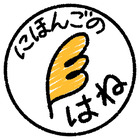
FREE Shintoism Notes (Paired w Google Form or PDF) Japan / Japanese Religion

Internment of Japanese Americans

Japanese : Hiragana handwriting worksheet

Animal in Hiragana

"Dareno (whose)" worksheet in Japanese

White Belt Unit 1 of 4 [Family Members video]

Hiragana Practice Chart(Trace the light-colored hiragana)

Hiragana Vowel Line Practice

Best Ever Vocabulary Assignment plus Peer Editing

Beginner Japanese - Genki textbook chapter test #1

Hiragana Practice K and S lines
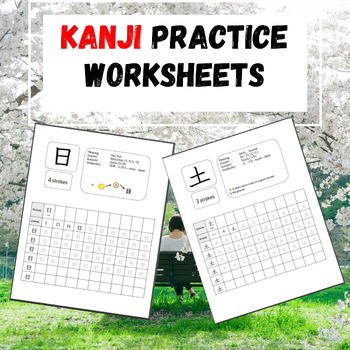
Kanji Practice worksheets for JLPT N5

DDJ Orange Belt Unit 3 of 4 [The Amazing Race] Self Introduction
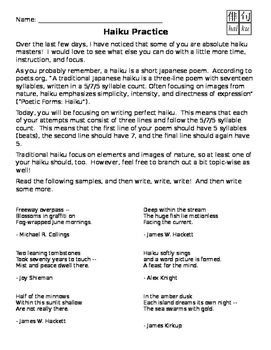
Haiku Writing Practice

Hiragana Vocabulary Reading Practice: あ through ご

Hiragana Katakana Heart
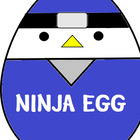
Basic Japanese: JLPT N5 level worksheet

Basic Japanese ( Particles : place /location で vs place/location に/で)

Japanese letter "Katakana"

Bilingual Summer Journal Writing

Pearl Harbor 1941
- We're hiring
- Help & FAQ
- Privacy policy
- Student privacy
- Terms of service
- Tell us what you think
- Create new account
- Reset your password
Register and get FREE resources and activities
Ready to unlock all our resources?
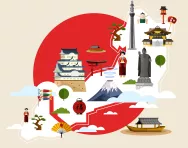
Japan is an Eastern Asian country in the Pacific Ocean , directly east of the Korean peninsula. It is filled with high-rise cities, thousands of shrines and temples and mountainous national parks.
Japan is a very modern nation, one of the world leaders in technology.
Top 10 facts
1. Japan is an island nation, which means it does not share land borders with other countries. Japan's closest neighbors are Russia , North Korea, South Korea, China and Taiwan.
2. The country is made up of over 6800 islands , but the four main ones (Hokkaido, Honshu, Shikoku and Kyushu) make up 98 per cent of its land area.
3. Mount Fuji is the highest mountain in Japan and, along with Mount Tate and Mount Haku, is one of Japan's ‘Three Holy Mountains’.
4. The largest city in Japan is Tokyo, also the country's capital . Other major cities include Osaka, Nagoya, and Sapporo.
5. The national currency in Japan is the Japanese Yen.
6. Some of the most well-known companies in the world are Japanese: Toyota, Honda, Sony, Nintendo, Canon, Panasonic, Toshiba, and Sharp.
7. The population of Japan is over 126 million. Life expectancy in Japan is 84 years, the second-highest in the world.
8. The main two religions in Japan are Shinto and Buddhism .
9. The world's oldest hereditary monarchy is Japanese; an emperor sits on the Chrysanthemum Throne.
10. Japanese traditional dress, for men and women, is the kimono . Kimonos are made from silk, have long sleeves, fall to the ankle and are tied with a special belt called an obi .

Start your child on a learning programme today!
- Weekly English, maths & science worksheets direct to your inbox
- Follows the National Curriculum
- Keeps your child's learning on track
Did you know?
Japan is located in one of the most geologically active regions in the world , along the ‘Pacific Ring of Fire’. The Japanese landscape has lots of volcanoes and hot springs and experiences many earthquakes and tsunamis .
The national flag of Japan is a white rectangular flag with a large red disc (representing the sun) in the centre. The flag is officially called Nisshōki, "sun-mark flag", in Japanese, but is more commonly known as Hinomaru, "circle of the sun".
One of the most famous Japanese dishes is sushi, pieces of raw fish and seafood placed on a ball of vinegared rice . Fugu , pufferfish, is a great delicacy but must be prepared by experts as it can be poisonous to eat!
Cleanliness and order are very important to Japanese people. Ritual bathing and removing shoes inside are still practised, and Japanese toilets are electrically powered and have up to 15 different buttons performing different cleansing functions!
Japan has a small land mass for the number of people who live in the country , so most people live in very small apartments in blocks of flats. There are even tiered car parks in cities.
Tea is as important to Japanese people as it is to British people. In tea ceremonies people drink green matcha tea while sitting and holding their cup in the traditional way.
The "bullet train", shinkansen , is the world's fastest passenger train, travelling at speeds of 320km per hour!
Slurping noodles and soup isn't considered rude in Japan, where people like to eat their food hot!
Hanami is a Japanese festival dedicated to flowers like cherry blossoms.
In traditional Japanese hotels, ryokan , people sleep on futons on the floor and there are paper screens separating the rooms instead of walls. There might be an onsen , a hot spring bath, where all the guests bathe together.
Browse through the gallery and see if you can spot the following:
- Japanese architecture
- Cherry blossoms
- Sushi, traditional Japanese food
- A Japanese temple
- Dharma dolls
- Japanese women wearing traditional kimonos
- The torii is the archway that is the gateway to a Shinto shrine
- Japanese traditional dress
- Traditional houses in Japan are made of wood and paper
- Kinkaku-ji, a Buddhist temple in Kyoto
- Japanese lanterns
- Snow monkeys in Japan
- Tokyo's skyline

Over 75 per cent of Japan is mountainous or hilly, and most of the population lives in huge urban areas. Tokyo's population is over 35 million (including suburbs), which makes it one of the largest cities in the world.
The Japanese language is spoken by more than 130 million people worldwide, with dozens of different dialects spoken within Japan. The two main groups of Japanese accents are Tōkyō-shiki (Tokyo-type) and Keihan-shiki (Kyoto-Osaka-type).
Japan has a parliamentary system of government like Britain. The Japanese do not elect a president directly.
Traditional Japanese Architecture has a distinct style deeply influenced by the religions Buddhism and Shinto. Japanese houses and temples are often made of wood that is placed on stilts to raise them above the ground. Japanese gardens are world-famous and usually contain stones, water features and bridges.
In Japan it is expected that you change into slippers when entering a Japanese home, a traditional restaurant, temples, and sometimes museums and art galleries. So if you are in Japan and you see a row of slippers, probably best to put them on!
Japan is home to many different forms of martial arts : Karate, Judo, Sumo, Ninjutsu, Kendo, Jujutsu and Aikido . Sumo wrestling is recognised as the national sport of Japan, although the most popular sport watched in Japan is baseball.
Japan is famous for its advanced technology. One of the most important Japanese 20th-century technologies to be invented is the compact disc (CD) which was created jointly by Sony and Philips in the late 1970s. Japanese people are the proud creators of hugely popular video games and toys (for example, Pokemon), and first introduced the world to technological innovations like robotic pets or motion sensor devices. Half of the world's robots can be found in Japan!
Matsuri means festival in Japanese. There are many different festivals and celebrations throughout the year, often marking important stages in the rice-growing season.
Related Videos
Just for fun...
Try some Japan-themed crafts like making a cherry blossom tree, a fan, samurai accessories and the ojami beanbags used to play the game of otedama
Print out some Japan colouring sheets
Free origami patterns and instructions will help you make almost anything in paper
Online games with a Japanese theme or setting
Take online Japanese lessons and learn to say basic phrases in Japanese
The hottests trends in Japanese school playgrounds : find out what's cool, from manga to moneyboxes
A complete guide to Japanese culture , from sumo wrestling and bento boxes to judo and bonsai
Design your own kimono online
Why not try cooking some Japanese food like yakisoba (noodles) or wagashi (sweets)? There are lots of recipes on Kids Web Japan
Download some templates for Japanese-themed models to make at home
Create your own paper Samurai helmet
Japanese wordsearches and worksheets
Make your own paper model of Himeji Castle in Japan
Children's books about Japan
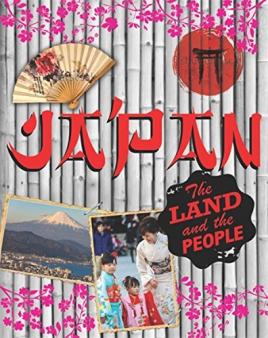
Find out more
An overview about Japan for kids
Everything you might want to know about Japan, from basic facts to descriptions of Japanese lifestyle and traditions
The Japan Society offers lots of videos and activities about Japanese culture
Haiku is a form of traditional poetry in Japan
The geography of Japan
Interesting and unusual facts about Japan (and some great pictures)
Find out more about Japanese folk tales
The main religions in Japan are Shinto and Buddhism
Read about the different kinds of food you could eat in Japan
Information about Samurai knights
Find out about kendo, one of traditional Japanese martial arts
Watch an animation to understand the history of rice paddies
See for yourself
Some of the best festivals, events, historical sites, parks and museums to visit in Japan
Find out more about Japanese World Heritage sites like the Ancient Kyoto, the Hiroshima Peace Memorial, Itsukushima Shinto Shrine and the temples of Nikko
Tokyo , Japan's capital city, is a vibrant place to visit

Give your child a headstart
- FREE articles & expert information
- FREE resources & activities
- FREE homework help

Summer Vacation Homework in Japanese Schools: Purpose And Types

In Japanese schools, students are often given a variety of homework during summer vacation. In this article, we will delve into the various types of homework, highlighting some unique assignments. We will also explore the concept of the “Independent research project” and explain its significance. By the end of this article, you will understand why homework are assigned during summer vacations in Japanese schools.
What Kind of Homework Is Given to Students During Summer Vacation?
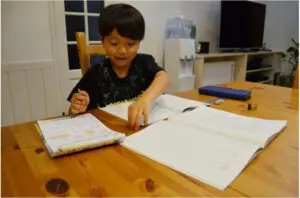
In most government elementary, junior, and high schools in Japan , summer vacation is normally for around 40 days , from middle of July to the end of August.
The amount of homework assigned varies by school, but generally , students are expected to do a certain amount of daily studyi ng t o align with the length of summer vacation. For example, in elementary school, students may be given tasks such as completing 2 pages of math and 1 page of Japanese each day.
In other words, students are expected to work on their homework daily .
However, schools ensure that they don’t assign an excessive or unmanageable amount of homework that would be difficult to complete during summer vacation.
Examples of Summer Vacation Homework
Homework assignments vary in each school. We will show you some examples here.
Elementary school students
1st to 3rd grades:.
・Kanji workbook
・Mathematics workbook
・Independent research project
・Picture diary
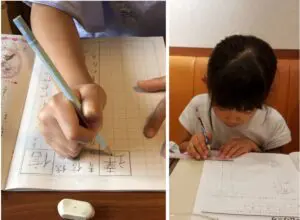
4th to 6th Grades:
・Review workbook for 4 subjects
・Book report/essay
・Home economics (sewing/cooking): Students are required to submit one completed work.
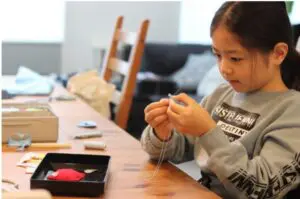
Junior high school students
Homework assigned to j unior high school students varies by school and teacher. Here are some examples :
・Workbooks for each subject (Japanese, math, social studies, science, English, etc…)
・Draw a poster about a specific theme
・Report of cooking at home
・Make a c raft
・Book report
What do students draw on a poster?

Creating a poster is more than just a picture ; i t requires a ke yw ord related to the theme. For instance, if the theme of the poster is environmental issues, traffic safety, or daily manners , the keyword will be “protect nature”.
Before drawing a poster, students need to decide on a theme, choose a keyword, and plan the layout. The keyword acts as a tagline.

What is “Independent Research Project”?

T he Independent research project gives students the freedom to make a decision of what to research, how to research, and the format of the final outcome.
Since this is a project, many students work on it for a certain period of the summer holidays, deepening their exploration of their own theme. It is a great opportunity to stimulate children’s desire to explore and give them the experience of building self-confidence by following through on what they have decided to do.
Here are some examples of independent research projects.
・Craft ing : Create items such as photo frames , candles, storage racks, etc.
・Experiment ing: Conduct experiments with materials like magnets, water, etc.
・Research ing: Explore topics like plant identification, transportation research, flower observation, or make your own picture books .
After summer vacation, many schools exhibit student s’ homework (summer research projects and posters) or organize presentation s about their assignments .
What is the purpose of summer vacation homework?

There are some reasons for assigning homewo rk during summer vacation.
Developing study habits
There are no regular school classes during the approximately 1-month summer vacation. Engaging in d aily learning during summer vacation helps students in a smooth transition to classes after the vacation. It also helps in maintai ning a consistent routine.
Strengthen Knowledge Through Review
Summer vacation homework mainly consists of reviewing material covered during the school year. By engaging in these assignments, students can assess their understanding and reinforce their knowledge through review.
This article has explored various aspects of summer vacation homewor k in Japan. We have discussed many kinds of unique assignments students receive , such as posters, independent research projects, and picture diaries. Those homework is not only aiming to strengthen knowledge but to develop their study habits.
Japanese students study hard while enjoying their longest break.
For those who want to know more about Japanese education
Shin Edupower provides programs that enable online exchange and collaboration between schools in India and Japan, as well as study tours to Japan for educators and students. If you would like to know more about education in Japan, please feel free to contact us here.
Last Updated on 2024-08-16
Related Posts

Why Do Japanese Students Clean and Serve Lunch at School ?

Japanese Educational System:From Preschool to Higher Education
You are using an outdated browser. Please upgrade your browser or activate Google Chrome Frame to improve your experience.
Daily Japanese Lessons for Busy People: 6 Resources for Any Schedule
Having a good daily routine is healthy for our minds and bodies , but it takes a lot of work to keep up with what we’d like to do every day.
This includes language-learning time.
Luckily, we found some awesome daily Japanese lessons that will absolutely help you achieve fluency in Japanese quickly and coherently.
Let’s look at why scheduling Japanese lessons every day is a wise choice to make.
6 Flexible Resources for Daily Japanese Lessons
Japanesepod101, nhk japanese, nihongo shark, why are daily japanese lessons important.
Download: This blog post is available as a convenient and portable PDF that you can take anywhere. Click here to get a copy. (Download)
The lessons below are ideal for any learner because they can fit into even the busiest schedule. We’ve included information about each resource as well as how to use them in your learning program.
Incorporate one or two (or all!) of these into your routine for a complete daily Japanese learning program!

JapanesePod101 is a great site to use if you’re just starting out learning Japanese.
Once you sign up, you’ll be able to start taking lessons immediately. Lessons typically include a video lecture, vocabulary list, homework ideas and downloadable cheat sheets.
Every aspect of Japanese is taught here, including reading, writing, speaking, listening and comprehension. These lessons are unique because you also can stay in touch with other students through comment sections that are available on every lesson page.
Depending on the plan you decide to purchase, you can also get access to a personal tutor in order to learn Japanese in a more classroom-like way.
The site features a few free lessons and resources, but you’ll have to get a membership in order to make full use of the lesson plans. Prices start at $25 per month depending on which plan you decide to try.
To use JapanesePod101 on a daily basis, experiment with how long it takes you to get through one lesson. Based on that, schedule however many lessons you can fit into 15 or 20 minutes every day.
Keep a notebook handy for notes or use JapanesePod101’s handy “save” feature to download vocabulary and lesson overviews for future reference.

Watching videos is a great way to make learning Japanese more fun! And watching authentic content is even more effective since it lets you hear the language as it’s actually used by real Japanese speakers.
The FluentU program uses authentic Japanese videos for an immersive learning experience.
The program’s library includes a wide variety of contemporary videos featuring native Japanese speakers. This means you’ll be able to experience modern Japanese as it’s spoken today in a variety of contexts, such as music videos, commercials, inspirational talks and more.
Every video is equipped with interactive captions in English and Japanese, which provide you with contextual definitions without leaving the video. You can toggle these on or off to fit your needs and save new words to personalized flashcards.
Personalized, multimedia quizzes help you study new words from your flashcard list as well as after each video.
The program is available on Android , iOS and through the web .

The program definitely has a “school” feel to it. Busuu even boasts that 22 hours of Busuu Premium lessons are equal to a college semester of Japanese.
A large emphasis is placed on writing exercises, but the program does focus on every other aspect of the Japanese language, as well.
You can also customize and personalize the lessons you wish to take by choosing topics of interest and the challenge level you’d like to try. Plus, if you’re out of data, you can enjoy “Offline Mode” with this handy little app as well.
You can use Busuu’s interactive exercises and some tests for free, but to access lessons you’ll need a Premium membership.
To start out, we suggest utilizing Busuu’s lessons for 10 minutes per day at the same time every day. Since the lessons are short, you’ll be more likely to actually do them, and by studying at the same time every day, you’ll build up a habitual routine that’ll get easier and easier to keep up.

NHK World is a massive Japanese culture site complete with Japanese news, radio, television, food and culture sections. Their language-learning section is especially handy and well-put together.
If you really like interactive learning through videos or audio, NHK Japanese has some lessons you’ll enjoy. Key phrases and words are the focus of each lesson, so if you’re trying to hone in on your reading and writing skills, this may not be the daily lesson for you.
All lessons are 100% free to use and you have the option to download both audio and lesson plans for future reference. Each lesson includes handy grammar tips as well.
In addition to daily lessons, you also have access to hiragana and katakana syllabaries and additional learning tools for further study.
The only downfall of NHK Japanese is that it’s hard for intermediate and advanced learners to use, as lessons start at an absolute beginner level.
To properly use these daily lessons, we suggest sticking to one lesson per day. The lessons on this resource are pretty short, so they’d be a great addition to other daily lessons you may be using.

Nihongo Shark has quite a lot of useful language-learning tools, but Niko’s Daily Lessons are definitely worthy of adding to your daily routine.
Each lesson includes images and stories from Niko himself, followed by phrase walk-throughs, pronunciation guides, audio files and flashcards. If you like blog-style lessons rather than rigid, academic lessons, you’ll enjoy learning with this resource.
Lessons are geared towards beginner and intermediate users, but advanced learners can certainly benefit from using some as a refresher.
If you choose to use this resource, we suggest that you take one lesson per day for 30 days and only use Niko’s Daily Lessons during that time. This is because each lesson is pretty packed with content, so taking simultaneous daily lessons may be overwhelming.
After 30 days, you’ll be ready to tackle any other resources you wish!

Memrise is a daily lesson app with a focus on Japanese vocabulary that works more like a video-game or digital board game rather than a structured lesson. It’s a strong tool for building vocabulary and uses Spaced Repetition to test and retest you on words until you’ve learned them thoroughly.
Words come with “memes”— visual and mnemonic notes to make what you’re learning more memorable. These memes are created by the community of learners and you can even make your own if none of the existing ones work for you.
Memrise has a number of official lessons to work through, but there are many other programs created by users, which you can browse on the website for learning everything from common verbs and nouns to essential anime words . Once you’ve added a program to your learning queue, you’ll also be able to access it on any of the mobile apps.
If you want to add a daily lesson to your study plan but can’t sacrifice much more time, Memrise is an ideal choice. It only takes about 10 minutes to learn five or more new words (you set your own learning goal) and review previously learned words.
Daily lessons have many benefits if you’re learning Japanese! Here are just a few:
- Daily practice is vital if you want to get fluent. Recalling what you’ve already learned is an excellent way to make sure you’re retaining your studies. By practicing every day, you’ll be placing that information firmly into your long-term memory and making sure you can draw on it whenever you need it.
- Learning new aspects of the Japanese language every day is also very important. You can study and practice to your heart’s content, but the core of learning Japanese is through lessons that teach you new information.
- Daily Japanese lessons can help language learners keep up momentum and learn Japanese quickly. People have a forgetting curve , which makes you forget things shortly after you learn them unless you reinforce them regularly.
- Structure is an important aspect of learning a new language. Learning bits and pieces of Japanese here and there might get you to a passable level in Japanese.
Related posts:
Enter your e-mail address to get your free pdf.
We hate SPAM and promise to keep your email address safe

Tell us more about yourself: Take our user survey now!
Been There, Learnt That: When Vacations Involve Homework
Taking the kids home for summer and dealing with assignments.

As kids head back to school, sighs of parental relief can be heard all across Japan. If your kids are in international school, they are probably excited about starting a brand new term. But if they are in a Japanese school, however, you sent them back for the second term with the pile of homework that schools assign over summer break.
Things vary among schools, grades and even teachers, but your typical Japanese elementary school student has to complete pages of kanji and math drills, book reports, a diary of what they did and, of course, the ubiquitous jiyu kenkyu , or “summer project.”
Japanese schools’ summer project assignments

Choosing a project can be a source of stress for parents and kids alike. As the vacation approaches, Japanese parenting magazines often have articles with suggestions, and home centers sell “project kits.” The best kind of project is something that is fun, educational and age-appropriate. Corin, an Australian mom of three, thinks they hit the trifecta with her daughter’s second-grade project this year.
“She is interested in nutrition, so she made a bilingual healthy food pyramid. She looked up some ideas for the pyramid online, and adapted one for herself. Then she wrote about it in Japanese on one side and in English on the other.” The final fun touch was adding cute food-shaped erasers from the ¥100 shop for a three-dimensional look. “Science, nutrition, art — it ticked all the boxes and it took her three days,” says Corin.
Our junior high school assigned the usual kanji and math drills, but on top of that, every subject teacher demanded some kind of summer project from the kids. For seventh grade home economics class, they had to plan, make and photograph a bento for a family member. For eighth grade art class, they had to go to an art museum of their choice and write a report about an exhibit. As you can imagine, however, some of the other projects were more painful.
Like many foreign mothers, I used to take my kids home each summer vacation. We typically flew out a day or two before the official end of the Japanese term, to take advantage of cheaper airfares. When my oldest was in seventh grade, I told his homeroom teacher of our plans and asked if we could get the summer homework packet one day early. The teacher indignantly informed me that homework packets are given out on the last day of class — and no sooner!
True to his word, the homeroom teacher did send out the packet to us by courier. My husband was traveling a lot for his work and by the time he was able to connect with the courier company, the summer vacation was more than half over. My husband ended up faxing the assignment sheets to my parent’s home for us.
Summer abroad … isn’t always about relaxation

If you’re fortunate enough to have the means and time to take your kids back to your home country for the summer, you know it isn’t just a case of showing up at grandma’s and relaxing for a month or so. Let’s face it — kids think it’s all about them and it can be hard when they’re removed from their familiar surroundings, friends and activities.
Grandparents, on the other hand, suddenly have their daily routines turned upside down by active little people. No matter how much they love their grandchildren, it can be stressful on both sides. And there you are, stuck in the middle and trying to appease everyone. I remember one vacation when my trio were bickering and yelling, and my mother just lost it. “You three are the most selfish kids I have ever met!” she yelled.
In our case, the solution was to send the kids to the local school for a month each time. Kiwis have an advantage in this respect, as we go home to winter when school is in session. Luckily, the local public school was totally on board with the idea, with the only stipulation being that our kids could communicate in English and that they would go for at least a month. Each of my kids began attending from age five, and my son went all the way through to age 12. It gave my kids structure to their day, their academic English got a huge boost and they learned about their mother’s culture. And Nana and Grandpa (and Mom!) got a bit of a break during the day.
Back home in Japan … and back to business

If you’re like me, coming back to Japan after an extended visit home is bittersweet. On the one hand, there is a sense of relief. It’s your house again, and you set the rules. However, you are now back to your routine — and yep… that includes the Japanese holiday homework!
Every year we went to New Zealand with the best of intentions about doing the homework, but it invariably got shelved until we came back to Japan, with a mad rush the last week to finish it. For the jiyu kenkyu project, my kids always found a way to tie it to their New Zealand experiences. In first and second grade, a photo file about daily life at a New Zealand school with simple captions was enough. As they got older, detailed reports on New Zealand wildlife or Maori culture were some of the ideas they worked on.
Some projects took on a life of their own. When my son was 10, he decided he wanted to “make a wooden ship” while visiting my parents. My father is a DIY kind of guy, so he enthusiastically offered his help. Most days, as soon as my son came home from school, Grandpa and grandson would disappear into the garage and work on the ship. It went through a few design changes and my son heard a few new vocabulary items when he inadvertently dropped a heavy tool on Grandpa’s foot. But it was a great bonding process for both. My son is a college senior now but the ship still sits on the bookshelf in his room.
But summers often bring unexpected surprises, too — which in itself is a way to learn new things. A friend of mine, Amanda, who took her two elementary-aged kids back to the U.S. for the summer, knows that well. Her son worked on a diorama for his project, and a lot of time, effort and materials went into its creation. When it was time to return to Japan, Amanda made a shocking discovery.
“ On the way to the airport, we realized we forgot the diorama! It was in a big square shoebox so we were going to carry it by hand. It was sitting by the front door all ready to go!” She ended up having to ask her parents to FedEx the item over, to the tune of US$170 dollars.
“Most expensive summer project ever!” Amanda says ruefully.
“ Been There, Learnt That ” is a monthly column in which Louise George Kittaka discusses various issues she went through when raising her three children in Japan. If you have any questions for Louise on a topic related to raising bicultural children in or out of Japan, send us an email at [email protected] or leave us a comment. Louise will answer your questions in her next article.
Leave a Reply Cancel reply
Your email address will not be published. Required fields are marked *
Save my name, email, and website in this browser for the next time I comment.
This site is protected by reCAPTCHA and the Google Privacy Policy and Terms of Service apply.
This Week(End)
Tokyo events for september 2024.

Up and Coming Artists
Komogomo art market.

Pandastic Times
China festival 2024.

Wagashi No Mori

The Land Before Time
Giant dinosaur exhibition 2024.

Dress Code: All-White Cocktail
Grand hyatt tokyo's soiree blanche, 50 ways to see, feel and taste tokyo.

Your Guide To The Best Things To Do In Tokyo!
Other articles by louise.

Tokyo’s Top Choices for Autumn & Halloween Afternoon Teas 2022

Kate Kamoshita of Learning Compass

Girls’ Weekend in Dogo Onsen, Matsuyama

On Cloud Nine: Living the High Life with Cé La Vi Tokyo

Cooking Up A Storm With Junior Chef Kiara
Contribute To Savvy Tokyo
Share your voice with savvy tokyo’s readers.
@savvytokyo What convenient apps do you use living in Tokyo?💧📲 #mymizu #freewater #lifeintokyo #lifeinjapan #ecofriendly ♬ やってみよう - WANIMA
Related Articles You Might Like

The Ins & Outs of Japanese Elementary School Holidays
All work and no play? Perhaps, this is the typical image many of us have of the way Japanese kids spend their summer holiday vacations...
By Kirsty Kawano

Been There, Learnt That: Raising Bilingual Children In Japan
What do you do when the option of sending your kids to an international school is non-existent and none of the recommended language development approaches...
By Louise George Kittaka

Is A Japanese School Best for Your Child?
What is best for my child? It’s an age-old question, and one that is sometimes easy to answer but often very difficult. When the topic...

Choosing an International School for Your Child
Japan is undergoing a rapid globalization of its education, and international schools are at the forefront of this change. The Tokyo area has some of...
By Mia Moranza
StudyMonkey
Your personal ai japanese tutor.
Learn Smarter, Not Harder with Japanese AI
Introducing StudyMonkey, your AI-powered Japanese tutor .
StudyMonkey AI can tutor complex Japanese homework questions, enhance your essay writing and assess your work—all in seconds.
No more long all-nighters
24/7 solutions to Japanese questions you're stumped on and essays you procrastinated on.
No more stress and anxiety
Get all your Japanese assignments done with helpful answers in 10 seconds or less.
No more asking friends for Japanese help
StudyMonkey is your new smart bestie that will never ghost you.
No more staying after school
AI Japanese tutoring is available 24/7, on-demand when you need it most.
The Japanese language is an East Asian language spoken by about 128 million people, primarily in Japan, where it is the national language. It is a member of the Japonic language family, and its relation to other languages, such as Korean, is debated.
AI Tutor for any subject
American college testing (act), anthropology, advanced placement exams (ap exams), arabic language, archaeology, biochemistry, chartered financial analyst (cfa) exam, communications, computer science, certified public accountant (cpa) exam, cultural studies, cyber security, dental admission test (dat), discrete mathematics, earth science, elementary school, entrepreneurship, environmental science, essay writer, farsi (persian) language, fundamentals of engineering (fe) exam, gender studies, graduate management admission test (gmat), graduate record examination (gre), greek language, hebrew language, high school entrance exam, high school, human geography, human resources, international english language testing system (ielts), information technology, international relations, independent school entrance exam (isee), lesson planner, linear algebra, linguistics, law school admission test (lsat), machine learning, master's degree, medical college admission test (mcat), meteorology, microbiology, middle school, national council licensure examination (nclex), national merit scholarship qualifying test (nmsqt), number theory, organic chemistry, project management professional (pmp), political science, portuguese language, probability, project management, preliminary sat (psat), public policy, public relations, russian language, scholastic assessment test (sat), social sciences, secondary school admission test (ssat), sustainability, swahili language, test of english as a foreign language (toefl), trigonometry, turkish language, united states medical licensing examination (usmle), web development, step-by-step guidance 24/7.
Receive step-by-step guidance & homework help for any homework problem & any subject 24/7
Ask any Japanese question
StudyMonkey supports every subject and every level of education from 1st grade to masters level.
Get an answer
StudyMonkey will give you an answer in seconds—multiple choice questions, short answers, and even an essays are supported!
Review your history
See your past questions and answers so you can review for tests and improve your grades.
It's not cheating...
You're just learning smarter than everyone else
How Can StudyMonkey Help You?
Hear from our happy students.
"The AI tutor is available 24/7, making it a convenient and accessible resource for students who need help with their homework at any time."
"Overall, StudyMonkey is an excellent tool for students looking to improve their understanding of homework topics and boost their academic success."
Upgrade to StudyMonkey Premium!
Why not upgrade to StudyMonkey Premium and get access to all features?

Link to Lessons
Click here to access all 48 lessons and learn the basics of Japanese conversation. Master daily greetings and travel phrases. The lessons also include sightseeing hints and cultural tips.

How to use this site
The website--with audio, animated video, and text--helps you learn the basics of Japanese. It offers 48 lessons. Here's how to use the site.
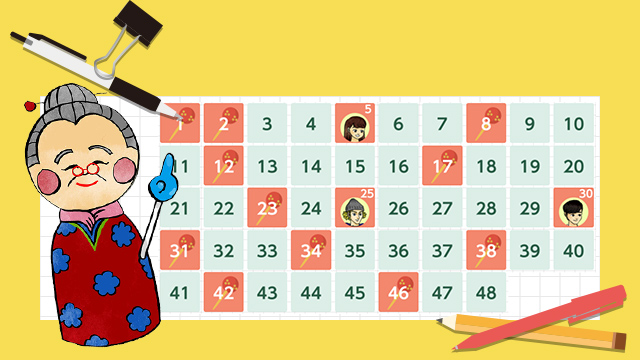
My Haru-san Track your progress
Keep track of your progress on your personalized My Haru-san page. Review your quizzes too, and register words and phrases you’d like to remember.

Resources for Downloading
MP3 audio files of the lessons and PDF files of the textbook can be downloaded free of charge (for personal use only).
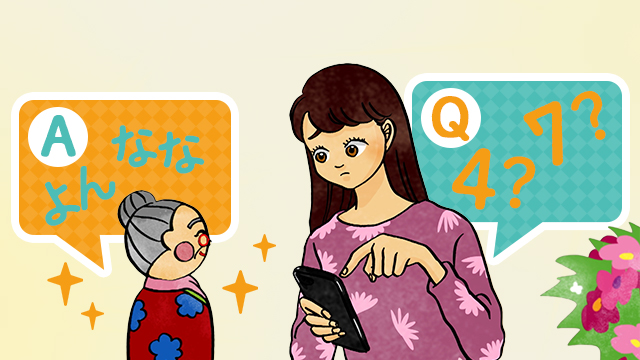
We'll Answer Your Questions
Program supervisors Fujinaga Kaoru and Isomura Kazuhiro respond to listeners' inquiries about the Japanese language.
Choose a Lesson

Japanese Letters

Key Phrases

See more…
Get the Reddit app
Welcome to r/LearnJapanese, *the* hub on Reddit for learners of the Japanese Language.
Homework Ideas?
Hi guys, I've been in a Japanese I class for a semester now and I wanted some advice on homework. My Japanese teacher has a policy that we are supposed to spend 20 minutes every night doing homework that we can show her the next day, so far I have been simply repeating writing words we learn in class, but I feel that is becoming less effective as I continue learning new words. Do you guys have advice as to what I should do or new learning styles?
By continuing, you agree to our User Agreement and acknowledge that you understand the Privacy Policy .
Enter the 6-digit code from your authenticator app
You’ve set up two-factor authentication for this account.
Enter a 6-digit backup code
Create your username and password.
Reddit is anonymous, so your username is what you’ll go by here. Choose wisely—because once you get a name, you can’t change it.
Reset your password
Enter your email address or username and we’ll send you a link to reset your password
Check your inbox
An email with a link to reset your password was sent to the email address associated with your account
Choose a Reddit account to continue

- Guest Houses
- Interview Tips
- Study English
Homework Correction
by Sophia McMillan (Shane Training Centre, Japan)

• Give learners a chance to compare their answers in pairs. They can then correct / change / complete their own answers before a whole class check. • Take names out of a hat to nominate who will answer (make sure this is done in a ‘fun’ way, explaining they have an opportunity to PASS if they want). • Use a ball nominate who gets to give their answer to questions. Whoever gets the ball throws it to the next learner. Again, give them an opportunity to pass if necessary. • Alternate between asking for answers to be volunteered and calling on specific learners to answer questions. • Pre-prepare a grid that includes the question numbers for the various exercises that are to be corrected. Leave a space next to each question number. At the beginning of the lesson, get learners to put their name down to answer the various questions. Tell them that, even if they did not do the homework they can still try to answer a question of their choice but do not force them to put their names down. Use the list to call on learners to answer the questions in turn. • Vary the order in which exercises are corrected • Change the time of the lesson in which homework is corrected. Most learners expect homework corrections to come right at the beginning of a lesson. • Provide mini keys of individual exercises to distribute to pairs. Learners then take it in turns to ‘play the teacher’ and check each other’s answers. Remember to provide an opportunity for the discussion of problem areas at the end of the pair-work session or at the end of the lesson. • Spot check on lexis by occasionally eliciting synonyms/ antonyms/ similar expressions/ analogous idioms of items taken from the exercises being corrected. • Create a multiple choice answer key for a few exercises where three possible answers to each question are provided, only one of which is correct. Learners then compare their own answers with the alternatives given, then choose the answer that they consider correct.
Make sure lots of praise and encouragement is given for answers that are even partly correct and, where possible, give positive feedback for areas that are not necessarily the focus of the exercise (such as good pronunciation in the case of grammatical errors or wrong answers in comprehension exercises).
Remember: learners quickly tune in to the mood of their teacher. If the teacher presents homework correction as a valid and interesting part of the learning process it will be infectious and homework corrections need never be boring again!Homework Correction
Share this:
About kintaro63
Leave a comment cancel reply.
- Search for:
Recent Posts
- Some of the Best Travel Literature of all Time
- Language Teaching Professionals
- American Dream
- How to do Well as a Udemy Instructor?
- School Owners Mini-Conference
- February 2024
- January 2024
- December 2023
- November 2023
- September 2023
- August 2023
- February 2023
- February 2022
- November 2021
- February 2021
- December 2020
- October 2020
- January 2020
- December 2019
- October 2019
- September 2019
- August 2019
- February 2019
- January 2019
- December 2018
- November 2018
- October 2018
- September 2018
- August 2018
- February 2018
- January 2018
- December 2017
- November 2017
- September 2017
- August 2017
- January 2017
- November 2016
- October 2016
- September 2016
- August 2016
- February 2016
- August 2013
- January 2013
- November 2012
- Entries feed
- Comments feed
- WordPress.com
How to Teach English in Japan
Top Posts & Pages
- Some of the Best Travel Literature of all Time
| M | T | W | T | F | S | S |
|---|---|---|---|---|---|---|
| 1 | 2 | 4 | 5 | |||
| 8 | 9 | 11 | ||||
| 13 | 14 | 15 | 16 | 17 | ||
| 22 | 24 | |||||
| 27 | 29 | 30 | ||||
- Airbnb; want to host ?
- Avanti Staff
- Breaking News English
- EFL Magazine
- Eikaiwa Owners Group
- English Online – Easy News Articles for Students
- ESL Library
- ESL Teachers Board
- ETJ Independents
- ETJ, English Teachers in Japan
- Flamingo find Students
- Free Video Editing for Teachers
- Gamification Software
- Hello Sensei
- I am Hakone
- ISL Collective
- JALT: Performance in Education
- Japan Living
- Japan Meteorological Agency
- JET Program
- Jobs in Japan
- Kevin R Burns
- Kevin`s English Schools
- Kevin`s Hakone Guest Houses
- Kevin`s Instructor Page at Udemy
- Kev`s Twisted Humor
- Kimi Information Centre
- Linguahouse
- Ohayo Sensei
- Online Courses Galore
- Open Online Digital Tools for Learning
- Shinyurigaokan, The
- Travel Writing from A-Z & Chat GPT
- West Tokyo JALT
Sports & Hobbies
- JIGG Kanagawa
- 10,724 hits
Recent Comments
| on |

- Already have a WordPress.com account? Log in now.
- Subscribe Subscribed
- Copy shortlink
- Report this content
- View post in Reader
- Manage subscriptions
- Collapse this bar

Japanese Arts & Culture from the Centre of Utrecht
Homework: one-minute-speech!
Last Friday, the study group had its first meeting. And the members also got their first homework assignment… 😉
Next Friday, everyone will give an “elevator pitch”, about a subject of their choice, in Japanese. Exciting! But how do you prepare something like that? In this blog, professional public speaker Juliet shares her tips and tricks.
And to inspire you, we also added the video essays from the Embassy of Japan in the Netherlands . Good luck with your preparations!
“A one-minute speech is not so much different from other regular speech if not for the length” Juliet explains, “however, the length makes you approach this kind of speech differently.” Here are Juliet’s tips on how to deliver a good speech in one minute:
1. Decide on a question
It would be best if you decided on a topic beforehand. This will go a long way in helping you prepare adequately for it. You may present your speech in a language you are not very familiar with. If that is the case, restrict your speech to topics that will include the more familiar syllabus.
Aside from having a topic in mind, you also have to streamline your speech to give out the value within a short period. Let’s take, for example, you want to talk about Japanese culture. What part of that culture would you like to focus on?
2. Have a central message
The timing is relatively short to run around several ideas. Try and limit your speech to communicating just one message. The more concise your concept is, the better. How memorable your speech depends on how you communicate this message. By revolving your messages around a single topic, you are making it easy for your audience to remember your speech. Just pick a topic that you are familiar with and communicate in the language you will be giving the speech.
3. Always have your audience in mind
Always have your audience in mind when preparing your speech. This will inform the kind of language you will use. If you are speaking to your classmates, the language you will use will be different from presenting a speech to corporate individuals.
4. Research
You may need to do some extra digging to prepare your speech. You may be wondering if it is not only a 1-minute speech. However, to give out so much value, you need to put in efforts to make it worthwhile to your listeners. Try and concentrate on what is essential.
5. Write down your speech
This is very important in preparing any speech, including a 1-minute speech. Go ahead and write down everything you want to say and practice it over and over again. When you are writing your speech, ask yourself, “what is the take home the audience can go with”?
6. Practice
It doesn’t matter if it is a 1-minute speech or a long speech, the place of preparation cannot be overlooked. It is tempting to conclude that you wouldn’t need to practice much because it is a 1-minute speech. On the contrary, practicing your speech is very vital. Constant practice will help you to maximize the time.
How to start your 1-minute speech
The beginning of your speech should be very engaging. This will keep your audience glued to your speech from the beginning to the end. However, being a one-minute speech, your focus may not necessarily be in the beginning. You can start with “I will keep this short.” It won’t be out of place to inform your audience that your speech will be a short one. This will help them pay more attention.
How to end your speech
You may want to save the essential part of your speech for last. This is because your audience will remember more of what you said at last. Mentioning your main idea in the middle of your speech is also not out of place. However, you need to ensure that you end your speech with it.

How to speak in a language you just started learning
It is possible to feel secure making presentations in a foreign language! The solution to this is to prepare adequately. You need to know the topic you want to speak on and the terms and relevant vocabulary in the presentation language. Give attention to the keywords and significant phrases to be used.
Saying the difficult words out loud will help a lot. Keep pronouncing it until you get comfortable with the terms. Always bear in mind that you are not a native speaker and have not yet become fluent in the language. Therefore, keep your speech as simple as possible and not to impress. While presenting your speech, if you make any grammar mistakes, try to overlook them. I bet you, the audience, will understand.
Pay more attention to your pronunciation so that you don’t communicate something different. Make deliberate efforts to speak slowly and audibly. Your memory can fail you. Having a brief note that you can quickly glance at may not be a bad idea at this point.
While on stage, if you can’t remember the pronunciation of a word, request feedback from the audience. This will also help in making the atmosphere lively and engaging. Don’t leave your speech to chance. The quality of a good speech is seen in the amount of time spent preparing it. Take out time and prepare for it and watch yourself shine before the audience.

As the Japan Fans Utrecht wish to form friendship bonds with Japan Fans from all over the world, we are very happy to publish this guest blog written in cooperation with Juliet Ijemaru. Juliet is a public speaker and coach from Nigeria. She has a diploma in public speaking and has been pivotal in helping many individuals actualize their speaking goals. Thank you, Juliet!
Starter box

15 Japanese Scrapbooking Ideas
Taking time off to visit the places you love is something everyone should do once in a while. One of the most amazing places to visit in the world is Japan . Although we have our smartphones to take pictures, scrapbooking is also a great way to preserve the amazing memories you make on your journey. Even if you’re a novice, all you need is some basic Japanese scrapbooking ideas to get you ready to create the best scrapbook ever.
When it comes to creating a Japan Scrapbook to document your journey , you have to be intentional and make sure to get the best pictures when you travel. Yes, living in the moment is also important, but to get a good scrapbook, you need to start taking pictures from the airport boarding to the food you need and natural sceneries, so bring out the photographer in you. If you don’t have a Polaroid camera, use your smartphone and then get the pictures printed after your trip. Also, if you have a lot of activities planned, start making the scrapbook when you return home; trying to make a scrapbook while on your trip to Japan can get overwhelming.
Now that you know the basics, let’s get right into it. In this article, we've curated 15 creative and diverse Japan scrapbook ideas that will help you design a scrapbook that beautifully captures your unique Japanese experience.
These are some ideas for making the best Japan scrapbook pages. You can choose to make each page a different design or choose a theme for your entire scrapbook.
- 1. Flight to Japan Page
- 2. Kanji Calligraphy Page
- 3. Photos from Japan Page
- 4. Temple Trails Page
- 5. Envelop Page
- 6. Washi Tape Page
- 7. Japanese Food Page
- 8. Japanese Scenery Spread
- 9. Little Scrap Book Page
- 10. Tickets Spread
- 11. Travel Map Spread
- 12. Cherry Blossom Scrapbook Page
- 13. Japanese Street Fashion Collage
- 14. Anime Adventure
- 15. Architectural Drawing Spread
Flight to Japan Page

If you want full documentation of your trip to Japan, start with your flight pictures . This is the perfect way to start your scrapbook, it will help you relive that nostalgic moment of arriving in Japan.
Kanji Calligraphy Page
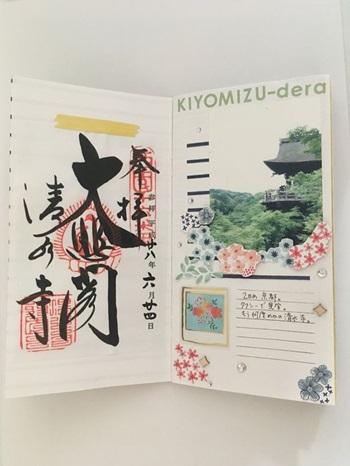
Japan is one of the few countries where people practice calligraphy from elementary school. Instead of getting a cool Kanji tattoo like many others, dedicate a page for calligraphy . Attach photos of beautiful scenery in Japan and write a bold kanji script of the town’s name. You can also find some popular Japanese quotes to add to the page. Finish it off with some stickers, and you have a great scrapbook page.
Photos from Japan Page

If you have more than one photo to tell the story of a place, you can play around with shapes and sizes to make everything fit on one page . Choose a primary photo and add the rest of the pictures around the main photo on a smaller scale and in different sizes. This would tell the story of the location without looking cramped up.
Temple Trails Page
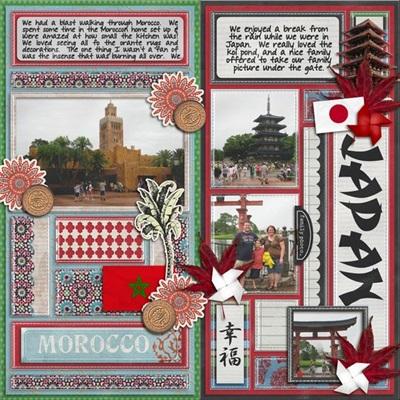
Did you know that Japan is home to more than 100,000 shrines ? When you go on a trip to Japan, there is no way that you would miss out on visiting a temple or two. Dedicate a section to the serene beauty of Japanese temples. Arrange photos of temple visits with some stickers and leave space for notes to record details of your visit. To make things more interesting, use traditional paper fans or torii gate stickers as embellishments.
Envelop Page
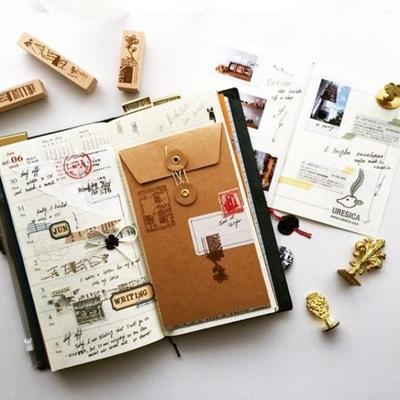
One way to store souvenirs safely inside your scrapbook is to create an envelope. You can put anything from sand or seashells from a beach to jewelry inside the envelope . That way, you won’t lose your precious treasures. You can use the other page to write notes on what is stored in the envelope.
Washi Tape Page

Washi tape is a very useful scrapbooking supply . When you want to make a photo the main focus of the page, you can use washi tape to create a border around it. You can also use it to craft origami embellishments to give your pages a 3D effect. Washi tape comes in many designs, from traditional patterns like waves and cranes to modern and kawaii ones. Its versatility allows you to add Japanese aesthetics to your layouts.
Japanese Food Page

Let’s be honest: while many people visit countries for the change of scenery, others do it for the food, and we can relate to that. You'll find some of the best Japanese snacks and weirdest ramen flavors in Japan. Devote a section of your scrapbook to the amazing food Japan has to offer. Capture the vibrant colors and textures of different types of meals in your photographs. Enhance the theme by adding food-themed stickers, washi tape borders, and hand-drawn chopsticks.
Japanese Scenery Spread

Create a collage-style layout that celebrates various aspects of Japanese culture. Make the background image an iconic Japanese landscape like Mount Fuji, then mix and match pictures of tea ceremonies, traditional dances, and colorful festivals. You can also use stickers or washi tape to create depth and a rich representation of Japan's diverse culture.
Little Scrap Book Page
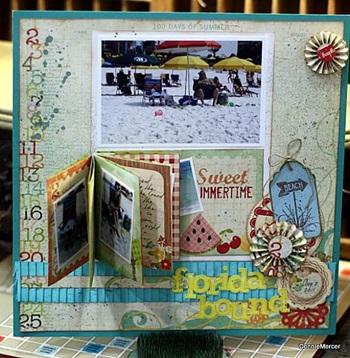
Even though it matters in many aspects of life , when scrapbooking, size does not matter. You can make a mini cute scrapbook inside your bigger one to store excess photos. That way, you can save space and really let the main photo take center stage while the smaller ones will make up your mini scrapbook.
Tickets Spread
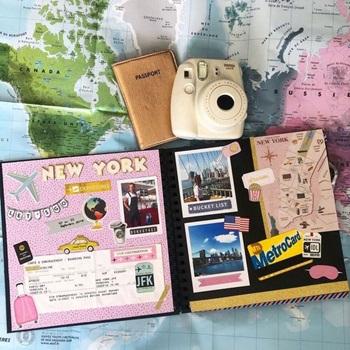
Tickets are more than just pieces of paper ; they're memories that transport you back to specific moments in your journey. Instead of throwing out all the tickets you used on your trip to Japan, create a ticket spread in your Japan scrapbook to weave together the various experiences and adventures you embarked on. One way to do this is to arrange them in a collage format, layering them in a visually pleasing arrangement. If you have too many tickets, you can use the envelope method to store some of them.
Travel Map Spread

A travel map is a visually appealing way to show where you visited in Japan . Design a two-page spread of a map of Japan, showing the cities and regions you visited. Pinpoint the locations with small stickers or draw adorable landmarks such as torii gates. Connect each destination with colorful trails to visually represent your journey across the country.
Cherry Blossom Scrapbook Page
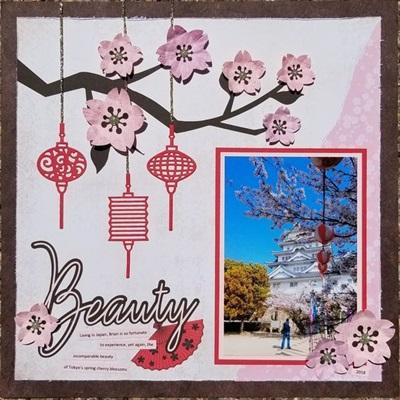
Depending on the season you visit Japan, you may get to see cherry blossoms bloom and even attend Hanami festivals . Create a dedicated section showcasing photographs taken during the Sakura season and make it a very pink and floral page. Use delicate floral washi tape with cherry blossom as borders, or frame your pictures with hand-drawn petals t bring the season to life.
Japanese Street Fashion Collage

Explore Japanese street fashion with a fashion spread. In some big cities in Japan, the fashion is considered avant-garde and extreme. You can find gyaru, loli, kimono-style, and fairy fashion styles . Be polite and ask if you can take pictures of people wearing outfits you love, then create a collage-style page representing the vibrant and trendy styles.
Anime Adventure

If you love Anime, then Japan would seem like paradise to you because of the many anime references. Restaurants would have anime-themed menus, and you’d see pictures of your favorite characters on buses or buildings. Try to take pictures of anime references and create a page for them. You can even add photos of cosplayers and locations you recognize from your favorite anime shows.
Architectural Drawing Spread

If you love architecture, you should definitely create a spread for the amazing buildings . Japan is a treasure trove of architectural wonders, blending ancient traditional buildings with modern ones. Designing an architecture spread in your Japan scrapbook allows you to showcase the richness of buildings, temples, and structures that define the country's landscape.
With these 15 Japan scrapbook ideas, you can embark on a creative journey that beautifully encapsulates the beauty of Japan. Happy crafting!
Have you been looking to buy some high-quality Japanese stationery? You can check out our ZenPop stationery store for the best deals from Japan.
This article was originally written by our freelance writer Umm-Kulthum Abdulkareem and edited by us.
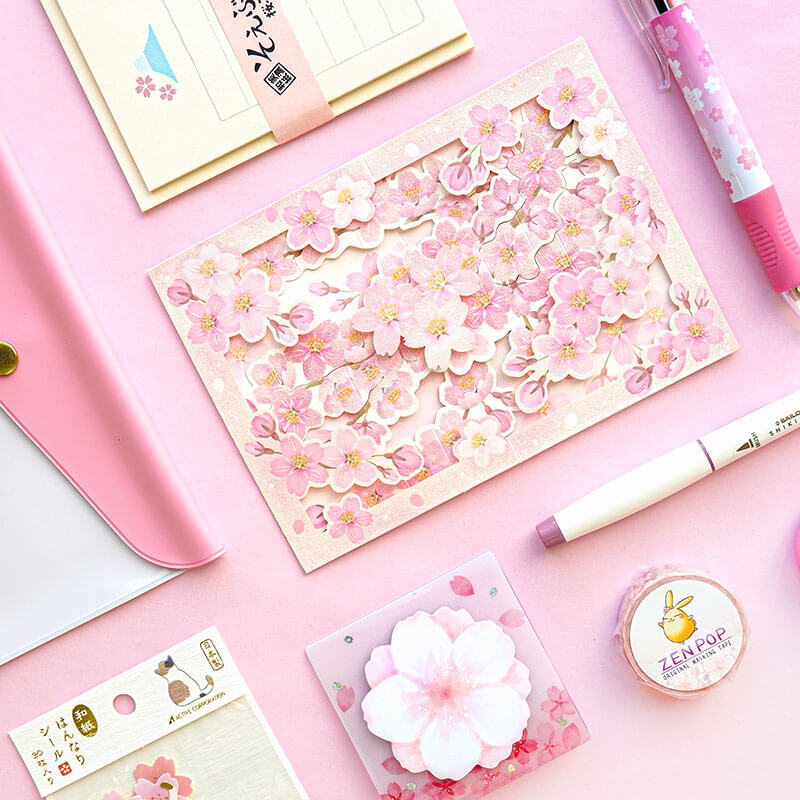
Japanese Stationery Box
Related posts:.
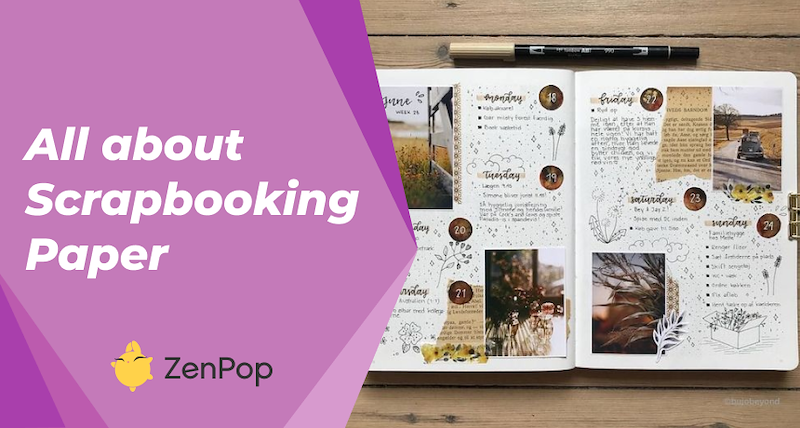
All about Scrapbooking Paper

All about Scrapbooking Stickers
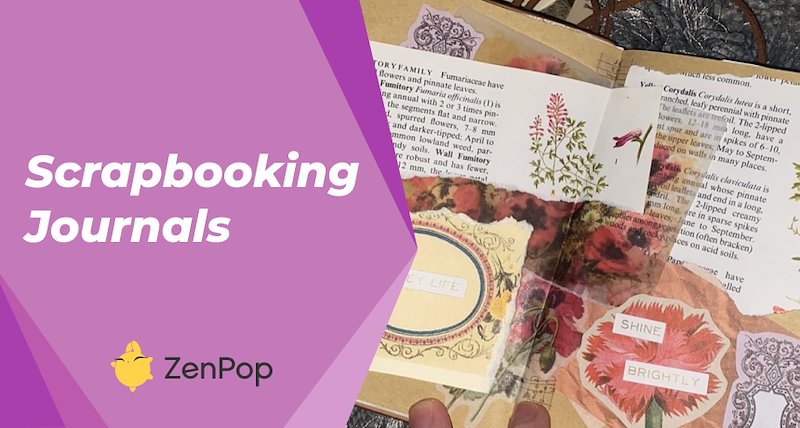
Types of Scrapbooking Journals

IMAGES
VIDEO
COMMENTS
The problem with jiyu kenkyu is that it is only one small but time-consuming part of the thick bundle of summer homework euphemistically called " natsu yasumi no tomo " ("summer break friend")—and boy, with friends like that…. It includes an 80-page workbook with drills covering each subject, extra printouts for kanji (Japanese ...
Japanese teaching ideas, the website where Japanese Language teachers exchange resources including art and crafts, flashcards, games, lesson and unit plans, songs, videos, useful websites, worksheets on various topics. ... Romaji desu is a Japanese/English dictionary - search for words in English or Japanese. ...
Japan, Anime, and Manga Essay Ideas for Homework Assignments. It is that time once again: back to school. That means essay writing! Part of the librarian profession is offering research help and writing instruction for high school and college students. Librarians are teachers at the core of the profession. So, it is time I did my part!
Take a peek in Games and activities to find out how to play some great interactive activities. Games are a fun way to help students improve their Japanese and become engaged. Many games and activities do require materials in order to play. However most can be easily made. Materials and templates can be found in the Teacher Resources section.
The Japan Project is a multi-lesson unit designed to give KS1 and KS2 students a cross-curricular introduction to Japan. The unit includes lessons on Japan's location, physical geography, climate, and wildlife and covers aspects of the Science, Art & Design, Computing and Geography curricula. It is intended to be taught whole, however ...
This site provides educators and specialists in Japan Studies a space for sharing, discussing and developing teaching ideas and resources about Japan, especially as they relate to K-12 classrooms. The site features thought-provoking essays; classroom-ready lesson plans; an area for asking and answering questions; resources including historical ...
Japan is made up of 6852 islands! The population of Japan is around 125.5 million. Mount Fuji stands at 3776m - the highest point in Japan. 'Nihon' or 'Nippon' are the Japanese names for Japan, meaning 'sun origin'. Nearly 75% of Japan's land is either forest of mountains. The national sport of Japan is Sumo.
Ideas for teaching Japanese writing including hiragana in the classroom, useful websites, board games, PowerPoints, videos, posters, flashcards, ... Practice writing hiragana words (6 pages) of homework exercises. Donated by F Scarth. booklet hiragana words: File Size: 825 kb: File Type: doc: Download File. Charts. Colour the strokes Hiragana chart
Katakana colour games (3 game boards) Divide the class into groups of three. Copy a game board for each group. Students start at 'Sutaato' and work their way to 'Gooru'. Taking turns, students must read the katakana character. If read correctly they can colour in the katakana square. (Ensure each student in the group has a different colour pen.)
Idea Book Series is a collection of lesson ideas, flash card and worksheet masters, game and activity ideas, each designed to be used easily and enjoyably in the classroom. Even for teachers whose knowledge of Japanese is limited, there are ideas to make teaching Japanese fun. These books were published by former KYOZAI - L.O.T.E. Teachign Aids.
Japan topic overview. Subject: Geography. Age range: 7-11. Resource type: Unit of work. File previews. doc, 79 KB. Half term plan overview based on national curriculum objectives- used by Year 3 and Year 4 but could be adapted for upper KS2. Creative Commons "Sharealike".
Topic: To not be (am not; is not; are not) This worksheet helps your students to learn how to form negative sentences in Japanese. It explains/shows a simple rule that helps students to master the basic skill (Japanese-Language Proficiency Test, N5 level). It can be used in class as well as a homework assignment.
Top 10 facts. 1. Japan is an island nation, which means it does not share land borders with other countries. Japan's closest neighbors are Russia, North Korea, South Korea, China and Taiwan.. 2. The country is made up of over 6800 islands, but the four main ones (Hokkaido, Honshu, Shikoku and Kyushu) make up 98 per cent of its land area.. 3. Mount Fuji is the highest mountain in Japan and ...
In most government elementary, junior, and high schools in Japan, summer vacation is normally for around 40 days, from middle of July to the end of August.. The amount of homework assigned varies by school, but generally, students are expected to do a certain amount of daily studyi ng t o align with the length of summer vacation. For example, in elementary school, students may be given tasks ...
Lessons typically include a video lecture, vocabulary list, homework ideas and downloadable cheat sheets. Every aspect of Japanese is taught here, including reading, writing, speaking, listening and comprehension. ... NHK World is a massive Japanese culture site complete with Japanese news, radio, television, food and culture sections. Their ...
As kids head back to school, sighs of parental relief can be heard all across Japan. If your kids are in international school, they are probably excited about starting a brand new term. But if they are in a Japanese school, however, you sent them back for the second term with the pile of homework that schools assign over summer break.
AI Japanese tutoring is available 24/7, on-demand when you need it most. The Japanese language is an East Asian language spoken by about 128 million people, primarily in Japan, where it is the national language. It is a member of the Japonic language family, and its relation to other languages, such as Korean, is debated.
Teaching ideas, art and craft, flashcards, games, lesson plans, songs, videos, ... Tt yells out Japanese words and the Ss slap the corresponding picture karuta. The Ss in the pair that slaps the quickest gets to keep the card. ... Includes homework task where students need to describe their school using prepositions.
Japan's public broadcaster, NHK, offers this fun and reliable Japanese language course to beginners. Download MP3 audio and PDF text lessons for free, and learn phrases you'll use right away.
Hi guys, I've been in a Japanese I class for a semester now and I wanted some advice on homework. My Japanese teacher has a policy that we are supposed to spend 20 minutes every night doing homework that we can show her the next day, so far I have been simply repeating writing words we learn in class, but I feel that is becoming less effective as I continue learning new words.
Homework Correction by Sophia McMillan (Shane Training Centre, Japan) These are just a few ideas of how to make whole-class correction of homework more of an active challenge. • Give learners a chance to compare their answers in pairs. They can then correct / change / complete their own answers before a whole class check.…
Here are Juliet's tips on how to deliver a good speech in one minute: 1. Decide on a question. It would be best if you decided on a topic beforehand. This will go a long way in helping you prepare adequately for it. You may present your speech in a language you are not very familiar with.
In this article, we've curated 15 creative and diverse Japan scrapbook ideas that will help you design a scrapbook that beautifully captures your unique Japanese experience. These are some ideas for making the best Japan scrapbook pages. You can choose to make each page a different design or choose a theme for your entire scrapbook.